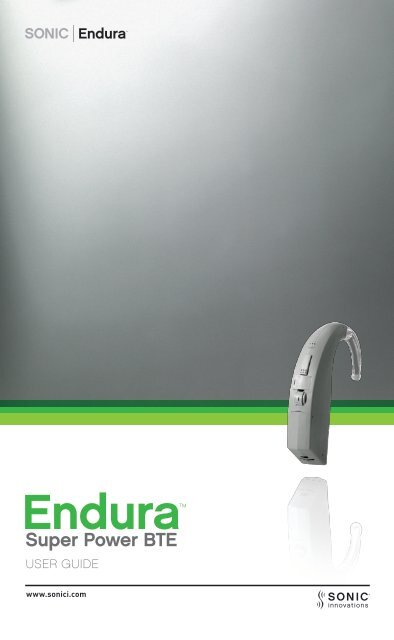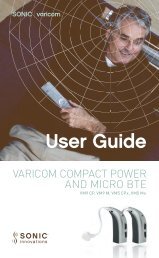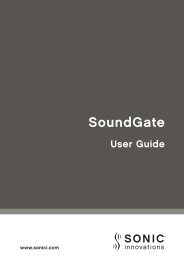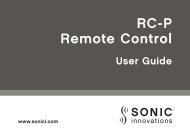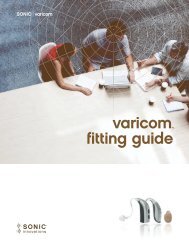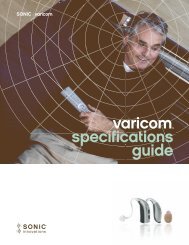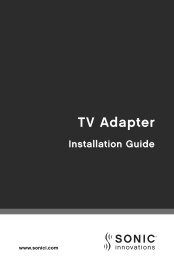Endura User Guide - Sonic Innovations
Endura User Guide - Sonic Innovations
Endura User Guide - Sonic Innovations
You also want an ePaper? Increase the reach of your titles
YUMPU automatically turns print PDFs into web optimized ePapers that Google loves.
Super Power BTE<br />
USER GUIDE<br />
www.sonici.com
Owner Information<br />
Hearing Aid Model: ________________<br />
Battery Size: 675<br />
Hearing Aid Serial Number:<br />
(Located inside battery compartment)<br />
Left:_______________ Right:________________<br />
Listening Program<br />
Number<br />
1<br />
2<br />
3<br />
4<br />
Listening Environment
Table of Contents<br />
Owner Information .......................................................2<br />
Hearing Expectations ...................................................4<br />
Your <strong>Endura</strong> Hearing Aid ..............................................6<br />
Turning Your <strong>Endura</strong> Hearing Aid On and Off ..............6<br />
Your <strong>Endura</strong> Hearing Aid ..............................................7<br />
Putting On Your <strong>Endura</strong> Hearing Aid ..........................9<br />
Removing Your <strong>Endura</strong> Hearing Aid ...........................10<br />
Removing Feedback/Squeal ........................................11<br />
Using the Volume Control ............................................12<br />
Using the Program Button ...........................................13<br />
Changing The Battery...................................................14<br />
Direct Audio Input .........................................................17<br />
Using the Telephone .....................................................19<br />
Safety Lock ...................................................................20<br />
SmartTones ...............................................................20<br />
Warranty .......................................................................21<br />
Repair ............................................................................21<br />
Troubleshooting ............................................................22<br />
Maintenance and Care .................................................24<br />
Warning to Hearing Aid <strong>User</strong>s .....................................25<br />
Get the Most from your Hearing Aid ............................26
SONIC INNOvatIONS<br />
Hearing Expectations<br />
Set Appropriate Expectations<br />
It is important that you have the right expectations<br />
regarding your hearing aids. Hearing aids will give you<br />
better hearing, but they are not a cure for hearing loss.<br />
People whose expectations are too high ("I thought<br />
they would make my hearing normal") are likely to be<br />
disappointed and may give up.<br />
Hearing Aids Can:<br />
• Help you hear and understand better in most<br />
situations.<br />
•<br />
Allow you to participate more in group situations<br />
and meetings.<br />
Hearing Aids Cannot:<br />
• Give you normal hearing.<br />
Hearing Aids May Not:<br />
• Let you hear very soft sounds.<br />
•<br />
Block ALL background noises–especially in<br />
noisy groups. Even people without hearing loss<br />
may have difficulty hearing in the presence of<br />
background noise.<br />
4
5<br />
eNdura uSer GuIde<br />
Be Patient<br />
Unlike eyeglasses, which correct your vision as soon<br />
as you first put them on, hearing aids need some time<br />
for proper adjustment. It may take several weeks or<br />
months to completely adjust to your hearing aids, so try<br />
to be patient. During the first week or so, try different<br />
listening situations, such as one-on-one conversations<br />
with family and friends and conversations with two<br />
or three people at home or in quiet settings. Also, try<br />
having conversations in noisier places like parties,<br />
restaurants, meetings, and outdoors. Do not forget<br />
that some situations are simply too noisy in general—<br />
even for people without hearing loss. So, do not get<br />
discouraged.<br />
Consistent use of your hearing aid is strongly<br />
recommended. In most cases, infrequent use does not<br />
allow you to obtain the full benefit from your aid.<br />
The use of a hearing aid is only a part of total hearing<br />
rehabilitation, and may need to be supplemented by<br />
auditory training and instruction in lip reading.
SONIC INNOvatIONS<br />
Your <strong>Endura</strong> Hearing Aid<br />
Your hearing aid has been programmed to fit your<br />
hearing and communication needs. If you feel your<br />
program needs to change, your hearing healthcare<br />
provider can make changes to improve the sound.<br />
Please review this instruction guide carefully. It contains<br />
information on the use and care of your hearing aid.<br />
With proper use and care, your hearing aid will improve<br />
your connection with the world around you.<br />
Turning Your <strong>Endura</strong> Hearing Aid On and Off<br />
Your hearing aid has a volume control; slowly rotate it<br />
upward to turn it on. You will feel a click as the hearing<br />
aid turns on. Continue to rotate the wheel up until<br />
the volume is at a comfortable level. To turn off your<br />
hearing aid, rotate the volume control wheel down until<br />
it clicks off.<br />
Your hearing aid may be programmed to alert you with<br />
SmartTones when it turns on or off. Your hearing<br />
healthcare provider will tell you if this feature is<br />
enabled. Your hearing aid may also have a "power on"<br />
delay. This allows you to insert the aid before it is fully<br />
active.<br />
6
Your <strong>Endura</strong> Hearing Aid<br />
Program Button<br />
Volume<br />
Control<br />
Battery<br />
Compartment<br />
7<br />
eNdura uSer GuIde<br />
Ear Hook<br />
Earmold<br />
Direct Audio Input<br />
Earmold<br />
Tubing
SONIC INNOvatIONS<br />
Labels<br />
BLUE tile indicates a<br />
LEFT hearing aid. RED<br />
tile indicates a RIGHT<br />
hearing aid.<br />
<strong>Sonic</strong> <strong>Innovations</strong><br />
Brand Name<br />
Year of Manufacture<br />
Serial Number<br />
8
9<br />
eNdura uSer GuIde<br />
Putting On Your <strong>Endura</strong> Hearing Aid<br />
Start with the hearing aid and earmold for your left ear.<br />
Rotate the volume control wheel down until it clicks off.<br />
If the earmold is not already attached to the hearing<br />
aid, connect the earmold to the hearing aid by pushing<br />
the hearing aid's ear hook into the tube on the<br />
earmold.<br />
Once the two are<br />
connected, hold the<br />
earmold with your<br />
thumb and first<br />
finger. Gently guide it<br />
into your ear canal.<br />
Gently pulling down<br />
on your ear lobe with your other<br />
hand may help. A slight twist may be<br />
needed to fit the earmold in your ear.<br />
When the earmold is in your ear, place the hearing aid<br />
behind the top part of your ear. Do the same thing with<br />
the right hearing aid and earmold.<br />
Rotate the volume control wheel up until the hearing<br />
aid turns on.
SONIC INNOvatIONS<br />
Removing Your <strong>Endura</strong> Hearing Aid<br />
To take your hearing<br />
aid off, hold the<br />
earmold with your<br />
thumb and first<br />
finger. Gently pull it out<br />
of your ear canal.<br />
A slight twist may be<br />
needed to remove it. Do<br />
not pull on the tube, as<br />
it may come out of the<br />
earmold.<br />
Once the earmold is out<br />
of your ear, remove the<br />
hearing aid from behind<br />
your ear.<br />
Reminder<br />
Even though they look the same, hearing aids are<br />
programmed to fit a specific ear (right or left). Make sure<br />
the correct hearing aid is used with the correct earmold.<br />
Refer to the right/left color indicator on page 8.<br />
10
Removing Feedback/Squeal<br />
11<br />
eNdura uSer GuIde<br />
Your hearing aid may have the ability to address<br />
feedback (whistle/squeal).<br />
To remove feedback:<br />
1.<br />
2.<br />
3.<br />
Make sure you are in a quiet environment.<br />
Press and hold the program button on your hearing<br />
aid for four seconds until you hear tones.<br />
Note: If you do not hear the tones, this feature is<br />
not enabled for your hearing aid.<br />
Remove your finger from the program button<br />
and from the vicinity of the hearing aid. You will<br />
hear several bursts of noise. Remain quiet and<br />
stationary while the bursts play.<br />
After your hearing aid is trained, it will return to your<br />
first listening program.
SONIC INNOvatIONS<br />
Using the Volume Control<br />
Your hearing aid is designed to adjust to the sound<br />
level of the environment around you. You should only<br />
need to make small volume changes to get natural and<br />
comfortable sound.<br />
In order to make these small changes, your hearing<br />
aid has a volume control that allows you to turn up or<br />
turn down the volume when needed. Rotate the volume<br />
control wheel up to turn up the volume as needed. If<br />
you need to lower the volume, slowly turn the volume<br />
control wheel down. Your hearing aid may play a series<br />
of SmartTones to let you know when you have reached<br />
your best listening setting for volume.<br />
Important<br />
If the volume of your hearing aid is too loud or soft<br />
when the volume control is all the way up, talk to your<br />
hearing healthcare provider. They may need to make<br />
changes to your fitting program.<br />
12
Using the Program Button<br />
13<br />
eNdura uSer GuIde<br />
Your hearing aid has a program button (see page 7). This<br />
button gives you the ability to choose different listening<br />
programs. When you turn the hearing aid off and then<br />
on, it automatically returns to program 1.<br />
Each time you press the button, you move to the next<br />
program. The sequence is 1, 2, 3, 4, 1, 2 ...<br />
Your hearing aid may use SmartTones to help you<br />
identify which program you are using. When you select<br />
program 1 you will hear one beep, program 2 will emit<br />
two beeps, and so on.<br />
Program SmartTone <br />
1<br />
2<br />
3<br />
4<br />
1 Beep<br />
2 Beeps<br />
3 Beeps<br />
4 Beeps<br />
Program Button<br />
Your hearing aid may also have Voice Alerts to help you<br />
identify which program you are using. When you push<br />
the program button, the name of the program you are<br />
switching to will be announced.<br />
Note<br />
Your hearing healthcare provider may not activate all<br />
programs.
SONIC INNOvatIONS<br />
Changing The Battery<br />
The life of your hearing aid battery will vary depending<br />
on your hearing program, the listening situation, and<br />
the length of daily use. A tone sequence will tell you<br />
when the battery in your hearing aid is low. When you<br />
hear the warning, change the battery in your hearing<br />
aid. If the battery gets so low that it cannot supply<br />
enough power to your hearing aid, a SmartTone power<br />
off sequence will play and the aid will shut off. Place a<br />
new battery in the aid to turn it back on. If your hearing<br />
aid is not in use, open the battery door to slow the<br />
battery use.<br />
Always remove the battery if your aid is not in use for<br />
long periods.<br />
Battery Type<br />
Rechargeable batteries are not recommended.<br />
Stainless steel zinc-air batteries are recommended.<br />
Your hearing aid uses a #675 battery.<br />
Note<br />
Batteries are small and can be harmful if swallowed.<br />
Keep batteries out of the reach of pets and small<br />
children. In case of ingestion, contact your physician.<br />
14
Remove the old battery<br />
1. Open the battery compartment.<br />
2.<br />
Remove and discard the old battery.<br />
15<br />
eNdura uSer GuIde<br />
Install a new battery<br />
1. Remove the colored tab from the zinc-air battery<br />
before putting it in the hearing aid.<br />
2.<br />
3.<br />
Insert the battery so the "+" sign on the battery<br />
matches the "+" sign on the battery door.<br />
Close the battery door.<br />
Turn the volume control wheel upward to turn the<br />
hearing aid on.<br />
Battery<br />
"+" Indicator<br />
+ +<br />
Battery Compartment
SONIC INNOvatIONS<br />
Change Batteries Regularly<br />
Assuming you use your <strong>Endura</strong> hearing aid<br />
approximately 12 hours a day, a single battery<br />
should last around 17 days. The exact battery life you<br />
experience may vary. When your battery needs to be<br />
changed you will hear the Low Battery SmartTone, a<br />
slow, double beep from a high to low pitch.<br />
If your hearing aid is not in use, open the battery<br />
compartment door to turn the aid off. This will prevent<br />
battery drain.<br />
16
Direct Audio Input<br />
DAI Cable<br />
17<br />
eNdura uSer GuIde<br />
Using the Direct Audio Input (DAI) with assistive<br />
listening devices may improve the understanding<br />
of speech in one-on-one conversations. It may also<br />
reduce stress in noisy environments. Insert the Euro<br />
plug of the assistive listening device into the DAI port<br />
on the bottom of the hearing aid. Talk to your hearing<br />
healthcare provider for details on assistive listening<br />
devices.<br />
Note<br />
When the DAI is connected to AC-powered equipment,<br />
this equipment must comply with IEC-60601 or equivalent<br />
safety standards.
SONIC INNOvatIONS<br />
Direct Audio Input Programs<br />
Your hearing healthcare provider may have programmed<br />
your hearing aid with special listening programs<br />
designed to work when a DAI device is attached. You<br />
access these programs with your program button just<br />
as you would any other listening program. Refer to the<br />
chart on the inside cover of this <strong>User</strong> <strong>Guide</strong> to determine<br />
the programs that use the DAI feature.<br />
Your hearing healthcare provider may have configured<br />
your hearing aid to automatically switch to your first<br />
DAI program when a DAI device is attached. If you<br />
attach the DAI device and the hearing aid does not<br />
automatically switch, use the program button to<br />
navigate to your DAI program.<br />
18
Using the Telephone<br />
19<br />
eNdura uSer GuIde<br />
Your hearing aid has a telecoil option that has the ability<br />
to pick up only the sounds coming from a hearing aidcompatible<br />
telephone.<br />
Your hearing healthcare<br />
provider can program your<br />
hearing aid to take advantage<br />
of this option. Refer to the<br />
chart on the inside cover of<br />
this <strong>User</strong> <strong>Guide</strong> to determine<br />
the program that uses the<br />
telecoil feature. When you<br />
have moved to the telecoil/<br />
telephone program, place<br />
the telephone handset lightly<br />
against your ear. Adjust the<br />
handset slightly up and/or back to<br />
find the position that gives the best sound.<br />
Your hearing aid may have an Auto Telephone feature,<br />
which automatically switches to the Telephone program<br />
when a phone is placed next to your hearing aid. If the<br />
Auto Telephone feature does not automatically engage, the<br />
magnetic field in your phone may not be strong enough. A<br />
small magnet was included with your hearing aid. Place<br />
the magnet on your phone, as shown in the included<br />
instructions, to improve the Auto Telephone switching.<br />
If your hearing aid has been configured without a<br />
telecoil option, select the program that is best for you<br />
when using the telephone. Then position the phone<br />
lightly against your ear as described above.
SONIC INNOvatIONS<br />
Safety Lock<br />
As an added safety feature, your battery door has been<br />
designed with a locking bolt to deter children from<br />
accessing the battery.<br />
To lock the door: With a thin, hard device such as a<br />
pair of tweezers move the locking bolt to the left as<br />
pictured. Reverse to unlock. This will prevent the<br />
battery door from opening and exposing the battery.<br />
Locking Bolt<br />
SmartTones<br />
Event Tone Description<br />
Start Up Delay A slow sequence of double beeps.<br />
Power On A fast sequence of beeps rising in pitch.<br />
Program Change<br />
Unlocked Locked<br />
A sequence of beeps rising in pitch. Number<br />
of beeps matches listening program position.<br />
Low Battery A slow, double beep from a high to low pitch.<br />
Dying Battery A fast sequence of beeps descending in pitch.<br />
20
Warranty<br />
21<br />
eNdura uSer GuIde<br />
Your hearing care provider will repair any defective<br />
hearing aid part within the period covered by your<br />
warranty. Ask your hearing healthcare provider for<br />
details. Labor and parts are covered by this limited<br />
warranty. If your hearing aid malfunctions, contact your<br />
hearing healthcare provider.<br />
Accessory items, such as batteries, are not covered<br />
under the warranty. Loss and damage due to misuse,<br />
abuse, accidents, tampering, or negligence are<br />
not covered under the warranty. If your hearing aid<br />
malfunctions, it must be serviced by an authorized<br />
hearing care providers service representative or your<br />
warranty may be voided.<br />
Note<br />
Your hearing healthcare provider may charge a service<br />
fee for processing warranty repairs.<br />
Repair<br />
Refer to the inside back cover of this booklet for the<br />
nearest repair facility or, if you have any questions<br />
regarding repairs, contact your hearing healthcare<br />
provider.
SONIC INNOvatIONS<br />
Troubleshooting<br />
If you are having trouble with your hearing aid, check<br />
this guide to quickly find a possible solution.<br />
Problem Solution<br />
No Sound<br />
Volume may be turned down Move Volume Control wheel up<br />
Battery may be low or dead Replace battery<br />
Hearing aid may not be on Turn on the hearing aid<br />
Start up delay is on Wait a few seconds for device to<br />
turn on<br />
Not Loud Enough<br />
Earmold not inserted properly Re-insert earmold<br />
Battery may be low or dead Replace the battery<br />
Program settings not optimum Consult your hearing healthcare<br />
provider<br />
Your hearing has changed Consult your hearing healthcare<br />
provider<br />
You may have excessive ear wax Consult your hearing healthcare<br />
provider<br />
Volume may be turned down Move Volume Control wheel up<br />
Program Button Doesn’t Work<br />
Battery may be low or dead Replace the battery<br />
Whistling or Feedback<br />
You may have excessive ear wax Consult your hearing healthcare<br />
provider<br />
Program settings not optimum Consult your hearing healthcare<br />
provider<br />
22
Problem Solution<br />
Sound is Distorted or Not Clear<br />
23<br />
eNdura uSer GuIde<br />
Battery may be low or dead Replace the battery<br />
Earmold not inserted properly Re-insert earmold<br />
Program settings not optimum Consult your hearing healthcare<br />
provider<br />
Battery Door Won’t Close<br />
Battery not positioned correctly Make sure the battery is<br />
properly positioned in the battery<br />
compartment.<br />
The "+" side must face the<br />
battery door.<br />
Debris in the battery<br />
compartment<br />
Remove the debris before<br />
inserting the battery
SONIC INNOvatIONS<br />
Maintenance and Care<br />
Your hearing aid needs to be cleaned daily. You can<br />
wipe the outside surface with a soft cloth or tissue.<br />
Always store your hearing aid inside its case when not<br />
in use.<br />
Important Care Tips<br />
•<br />
•<br />
•<br />
•<br />
•<br />
•<br />
•<br />
•<br />
•<br />
Keep the hearing aid in a safe place, out of the<br />
reach of pets and small children.<br />
Remove the battery when storing the hearing aid<br />
for long periods.<br />
When changing the battery, work over a table<br />
or countertop to keep the aid and battery from<br />
dropping.<br />
Use a soft brush to clean difficult-to-reach areas.<br />
Do not drop the hearing aid.<br />
Do not expose to moisture or submerge in water.<br />
Avoid harsh temperatures, including excessive heat.<br />
Avoid wearing your hearing aid while applying hair spray.<br />
Consult your physician if excessive earwax, skin<br />
irritation, or a foreign object prevents you from<br />
wearing your hearing aid.<br />
To avoid the need for repairs not covered by the warranty:<br />
•<br />
•<br />
•<br />
Never immerse the hearing aid in water or other<br />
liquids as this may cause permanent damage to<br />
the circuitry.<br />
Protect your hearing aid from rough handling, and<br />
avoid dropping it on hard surfaces or floors.<br />
Do not leave the hearing aid in or near direct heat<br />
or sunlight as excessive heat can damage the<br />
hearing aid or deform the earmold.<br />
24
Warning to Hearing Aid <strong>User</strong>s<br />
!<br />
25<br />
eNdura uSer GuIde<br />
Special care should be exercised in selecting<br />
and fitting a hearing aid whose maximum<br />
sound pressure level exceeds 132 decibels<br />
because there may be risk of impairing the<br />
remaining hearing of the hearing aid user.<br />
Consult your physician if excessive earwax, skin<br />
irritation, or a foreign object prevents you from wearing<br />
your hearing aid.<br />
Always remove the aid while undergoing any kind of<br />
electromagnetic treatment such as X-Rays, Magnetic<br />
Resonance Imaging (MRI), Computerized Axial<br />
Tomography (CAT), Electroencephalogram (EEG),<br />
Electrocardiogram (EKG), Short Wave Diathermy, or<br />
other electrical or magnetic treatment.<br />
Other types of radiation (burglary alarms, room<br />
surveillance systems, radio equipment, mobile<br />
telephone, etc) will not damage the hearing aid. They<br />
could, however, momentarily affect the sound quality or<br />
create strange sounds in the hearing aids.<br />
Do not wear the hearing aids in mines or other<br />
explosive areas, unless those areas are certified for<br />
hearing aid use.<br />
Keep the hearing aids away from children under the<br />
age of 3 since they contain small parts which may<br />
present a choking hazard.
SONIC INNOvatIONS<br />
Get the Most from your Hearing Aid<br />
Consistent use of your hearing aid is strongly<br />
recommended. In most cases, infrequent use does not<br />
allow you to obtain the full benefit from your aid.<br />
Your hearing healthcare provider can also assist you in<br />
other hearing improvement techniques. The use of a<br />
hearing aid is only part of hearing rehabilitation. Your<br />
hearing aid may need to be supplemented by auditory<br />
training and instruction in speech reading. No hearing<br />
aid completely restores normal hearing.<br />
26
<strong>Sonic</strong> <strong>Innovations</strong>, Inc.<br />
An Otix Global Subsidiary<br />
4246 Riverboat Road, Suite 300<br />
Salt Lake City, Utah 84123<br />
United States of America<br />
(888) 678-HEAR (4327)<br />
27<br />
eNdura uSer GuIde<br />
<strong>Sonic</strong> <strong>Innovations</strong> GmbH<br />
Mexikoring 33<br />
22297 Hamburg Germany<br />
Customer Service Germany: +49 (40) 61 1075<br />
Customer Service International: +49 (40) 63 919929<br />
Austria:<br />
+43 34 52 848 21<br />
Sailergasse 14<br />
Leibnitz<br />
8430<br />
austria<br />
Canada:<br />
800-667-7664<br />
920 Industriel Blvd<br />
terrebonne<br />
Quebec<br />
J6Y 1X1<br />
Canada<br />
Australia:<br />
1800 807 022<br />
3 unley rd<br />
Parkside<br />
South australia<br />
5063
!<br />
www.sonici.com<br />
© 2010 <strong>Sonic</strong> <strong>Innovations</strong>, Inc. all rights reserved.<br />
this booklet must be accompanied by supplement 4001341 in the u.S.a.<br />
4001456.A<br />
This device can be programmed to exceed 132 dB SPL.<br />
Do not let others listen to your hearing aid without a<br />
properly filtered stethoscope.


